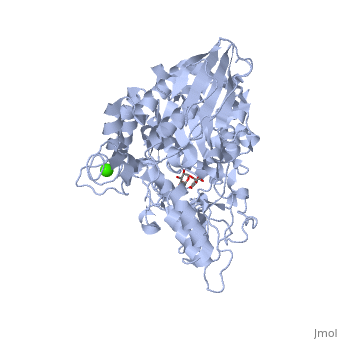|
|
| Line 3: |
Line 3: |
| | <StructureSection load='3axh' size='340' side='right'caption='[[3axh]], [[Resolution|resolution]] 1.80Å' scene=''> | | <StructureSection load='3axh' size='340' side='right'caption='[[3axh]], [[Resolution|resolution]] 1.80Å' scene=''> |
| | == Structural highlights == | | == Structural highlights == |
| - | <table><tr><td colspan='2'>[[3axh]] is a 1 chain structure with sequence from [https://en.wikipedia.org/wiki/Atcc_18824 Atcc 18824]. Full crystallographic information is available from [http://oca.weizmann.ac.il/oca-bin/ocashort?id=3AXH OCA]. For a <b>guided tour on the structure components</b> use [https://proteopedia.org/fgij/fg.htm?mol=3AXH FirstGlance]. <br> | + | <table><tr><td colspan='2'>[[3axh]] is a 1 chain structure with sequence from [https://en.wikipedia.org/wiki/Saccharomyces_cerevisiae Saccharomyces cerevisiae]. Full crystallographic information is available from [http://oca.weizmann.ac.il/oca-bin/ocashort?id=3AXH OCA]. For a <b>guided tour on the structure components</b> use [https://proteopedia.org/fgij/fg.htm?mol=3AXH FirstGlance]. <br> |
| - | </td></tr><tr id='ligand'><td class="sblockLbl"><b>[[Ligand|Ligands:]]</b></td><td class="sblockDat" id="ligandDat"><scene name='pdbligand=CA:CALCIUM+ION'>CA</scene>, <scene name='pdbligand=GLC:ALPHA-D-GLUCOSE'>GLC</scene></td></tr> | + | </td></tr><tr id='method'><td class="sblockLbl"><b>[[Empirical_models|Method:]]</b></td><td class="sblockDat" id="methodDat">X-ray diffraction, [[Resolution|Resolution]] 1.8Å</td></tr> |
| - | <tr id='related'><td class="sblockLbl"><b>[[Related_structure|Related:]]</b></td><td class="sblockDat"><div style='overflow: auto; max-height: 3em;'>[[3aj7|3aj7]], [[3a4a|3a4a]], [[3axi|3axi]]</div></td></tr>
| + | <tr id='ligand'><td class="sblockLbl"><b>[[Ligand|Ligands:]]</b></td><td class="sblockDat" id="ligandDat"><scene name='pdbligand=CA:CALCIUM+ION'>CA</scene>, <scene name='pdbligand=GLC:ALPHA-D-GLUCOSE'>GLC</scene></td></tr> |
| - | <tr id='gene'><td class="sblockLbl"><b>[[Gene|Gene:]]</b></td><td class="sblockDat">IMA1, FSP2, YGR287C ([https://www.ncbi.nlm.nih.gov/Taxonomy/Browser/wwwtax.cgi?mode=Info&srchmode=5&id=4932 ATCC 18824])</td></tr> | + | |
| - | <tr id='activity'><td class="sblockLbl"><b>Activity:</b></td><td class="sblockDat"><span class='plainlinks'>[https://en.wikipedia.org/wiki/Oligo-1,6-glucosidase Oligo-1,6-glucosidase], with EC number [https://www.brenda-enzymes.info/php/result_flat.php4?ecno=3.2.1.10 3.2.1.10] </span></td></tr>
| + | |
| | <tr id='resources'><td class="sblockLbl"><b>Resources:</b></td><td class="sblockDat"><span class='plainlinks'>[https://proteopedia.org/fgij/fg.htm?mol=3axh FirstGlance], [http://oca.weizmann.ac.il/oca-bin/ocaids?id=3axh OCA], [https://pdbe.org/3axh PDBe], [https://www.rcsb.org/pdb/explore.do?structureId=3axh RCSB], [https://www.ebi.ac.uk/pdbsum/3axh PDBsum], [https://prosat.h-its.org/prosat/prosatexe?pdbcode=3axh ProSAT]</span></td></tr> | | <tr id='resources'><td class="sblockLbl"><b>Resources:</b></td><td class="sblockDat"><span class='plainlinks'>[https://proteopedia.org/fgij/fg.htm?mol=3axh FirstGlance], [http://oca.weizmann.ac.il/oca-bin/ocaids?id=3axh OCA], [https://pdbe.org/3axh PDBe], [https://www.rcsb.org/pdb/explore.do?structureId=3axh RCSB], [https://www.ebi.ac.uk/pdbsum/3axh PDBsum], [https://prosat.h-its.org/prosat/prosatexe?pdbcode=3axh ProSAT]</span></td></tr> |
| | </table> | | </table> |
| | == Function == | | == Function == |
| - | [[https://www.uniprot.org/uniprot/MALX3_YEAST MALX3_YEAST]] Major isomaltase (alpha-1,6-glucosidase) required for isomaltose utilization. Preferentially hydrolyzes isomaltose, palatinose, and methyl-alpha-glucoside, with little activity towards isomaltotriose or longer oligosaccharides. Does not hydrolyze maltose.<ref>PMID:15291818</ref> <ref>PMID:20562106</ref>
| + | [https://www.uniprot.org/uniprot/MALX3_YEAST MALX3_YEAST] Major isomaltase (alpha-1,6-glucosidase) required for isomaltose utilization. Preferentially hydrolyzes isomaltose, palatinose, and methyl-alpha-glucoside, with little activity towards isomaltotriose or longer oligosaccharides. Does not hydrolyze maltose.<ref>PMID:15291818</ref> <ref>PMID:20562106</ref> |
| | <div style="background-color:#fffaf0;"> | | <div style="background-color:#fffaf0;"> |
| | == Publication Abstract from PubMed == | | == Publication Abstract from PubMed == |
| Line 28: |
Line 26: |
| | __TOC__ | | __TOC__ |
| | </StructureSection> | | </StructureSection> |
| - | [[Category: Atcc 18824]] | |
| | [[Category: Large Structures]] | | [[Category: Large Structures]] |
| - | [[Category: Oligo-1,6-glucosidase]] | + | [[Category: Saccharomyces cerevisiae]] |
| - | [[Category: Kusunoki, M]] | + | [[Category: Kusunoki M]] |
| - | [[Category: Miyake, H]] | + | [[Category: Miyake H]] |
| - | [[Category: Osaki, S]] | + | [[Category: Osaki S]] |
| - | [[Category: Yamamoto, K]] | + | [[Category: Yamamoto K]] |
| - | [[Category: Hydrolase]]
| + | |
| Structural highlights
Function
MALX3_YEAST Major isomaltase (alpha-1,6-glucosidase) required for isomaltose utilization. Preferentially hydrolyzes isomaltose, palatinose, and methyl-alpha-glucoside, with little activity towards isomaltotriose or longer oligosaccharides. Does not hydrolyze maltose.[1] [2]
Publication Abstract from PubMed
The structures of the E277A isomaltase mutant from Saccharomyces cerevisiae in complex with isomaltose or maltose were determined at resolutions of 1.80 and 1.40A, respectively. The root mean square deviations between the corresponding main-chain atoms of free isomaltase and the E277Alpha-isomaltose complex structures and those of free isomaltase and the E277A-maltose complex structures were found to be 0.131A and 0.083A, respectively. Thus, the amino acid substitution and ligand binding do not affect the overall structure of isomaltase. In the E277A-isomaltose structure, the bound isomaltose was readily identified by electron densities in the active site pocket; however, the reducing end of maltose was not observed in the E277A-maltose structure. The superposition of maltose onto the E277A-maltose structure revealed that the reducing end of maltose cannot bind to the subsite +1 due to the steric hindrance from Val216 and Gln279. The amino acid sequence comparisons with alpha-glucosidases showed that a bulky hydrophobic amino acid residue is conserved at the position of Val216 in alpha-1,6-glucosidic linkage hydrolyzing enzymes. Similarly, a bulky amino acid residue is conserved at the position of Gln279 in alpha-1,6-glucosidic linkage-only hydrolyzing alpha-glucosidases. Ala, Gly, or Asn residues were located at the position of alpha-1,4-glucosidic linkage hydrolyzing alpha-glucosidases. Two isomaltase mutant enzymes - V216T and Q279A - hydrolyzed maltose. Thus, the amino acid residues at these positions may be largely responsible for determining the substrate specificity of alpha-glucosidases.
Steric hindrance by 2 amino acid residues determines the substrate specificity of isomaltase from Saccharomyces cerevisiae.,Yamamoto K, Miyake H, Kusunoki M, Osaki S J Biosci Bioeng. 2011 Sep 16. PMID:21925939[3]
From MEDLINE®/PubMed®, a database of the U.S. National Library of Medicine.
See Also
References
- ↑ Yamamoto K, Nakayama A, Yamamoto Y, Tabata S. Val216 decides the substrate specificity of alpha-glucosidase in Saccharomyces cerevisiae. Eur J Biochem. 2004 Aug;271(16):3414-20. PMID:15291818 doi:10.1111/j.1432-1033.2004.04276.x
- ↑ Teste MA, Francois JM, Parrou JL. Characterization of a new multigene family encoding isomaltases in the yeast Saccharomyces cerevisiae, the IMA family. J Biol Chem. 2010 Aug 27;285(35):26815-24. doi: 10.1074/jbc.M110.145946. Epub, 2010 Jun 18. PMID:20562106 doi:10.1074/jbc.M110.145946
- ↑ Yamamoto K, Miyake H, Kusunoki M, Osaki S. Steric hindrance by 2 amino acid residues determines the substrate specificity of isomaltase from Saccharomyces cerevisiae. J Biosci Bioeng. 2011 Sep 16. PMID:21925939 doi:10.1016/j.jbiosc.2011.08.016
|

